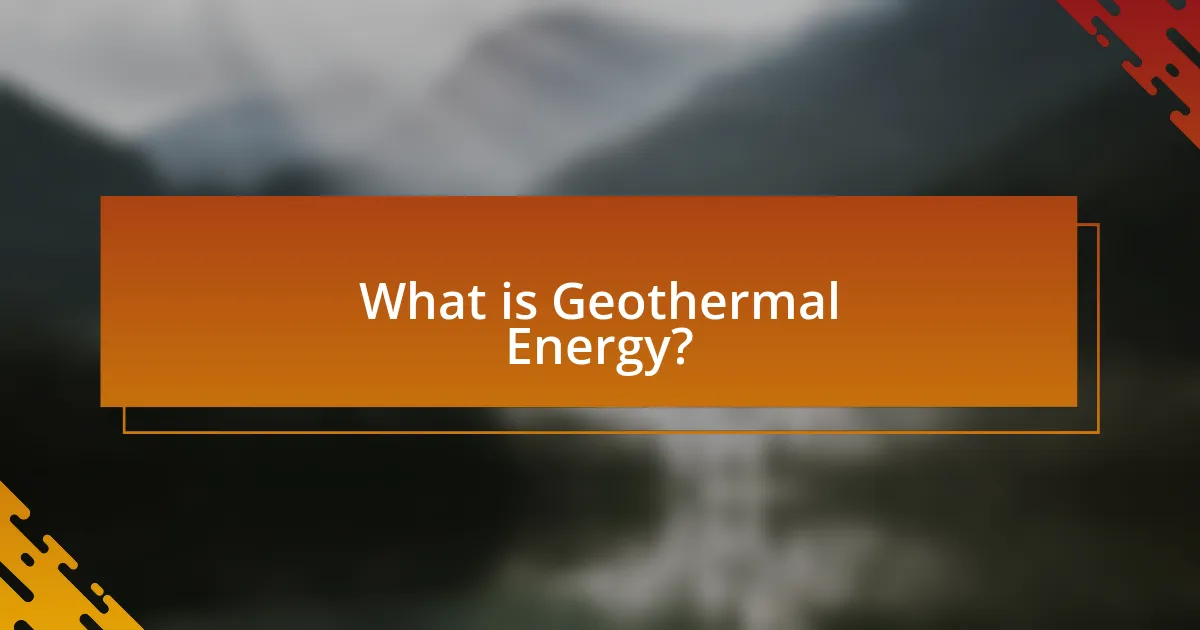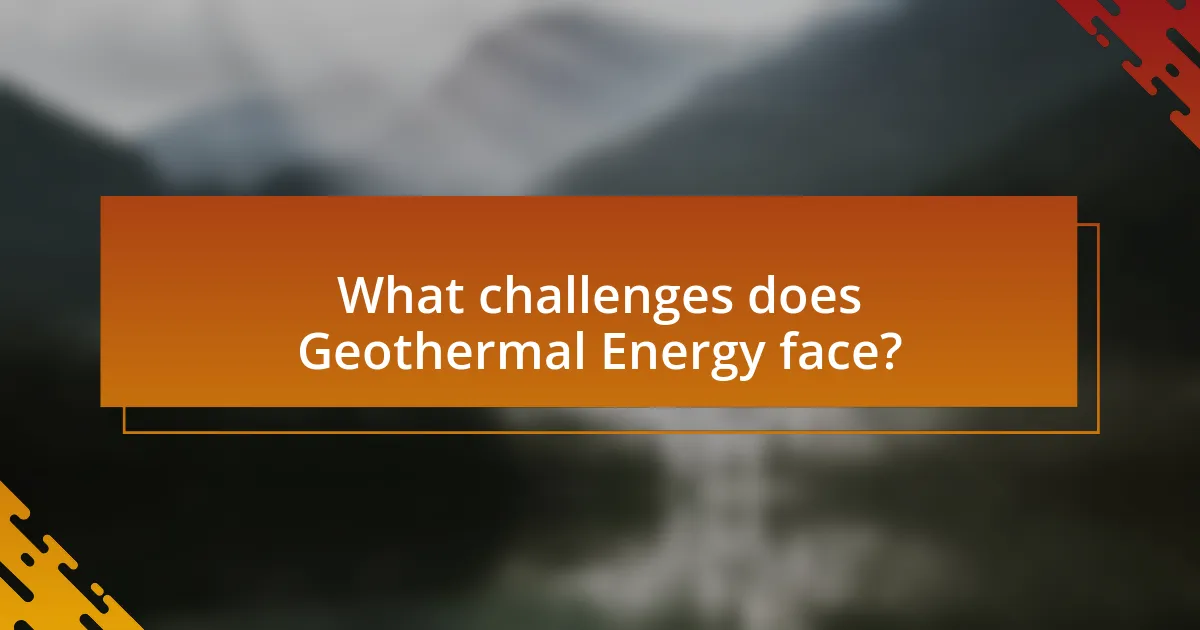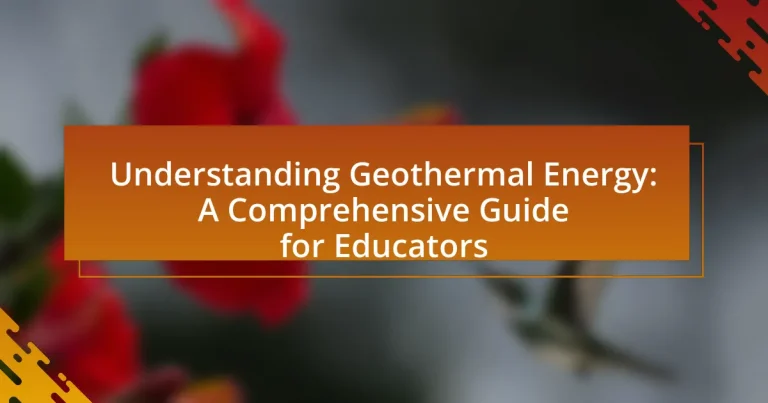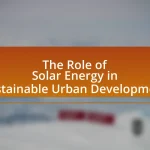Geothermal energy is the heat derived from the Earth’s interior, utilized for electricity generation and direct heating applications. This comprehensive guide explores the generation of geothermal energy, its various types, and the operation of geothermal power plants, highlighting its importance in providing a sustainable and reliable energy source. The article also addresses the environmental benefits, applications in residential heating, and the role of geothermal energy in electricity generation, while discussing the challenges and economic barriers faced in its development. Additionally, it offers insights into effective teaching methods and resources for educators to convey geothermal energy concepts.

What is Geothermal Energy?
Geothermal energy is the heat that comes from the Earth’s interior, which can be harnessed for various applications, including electricity generation and direct heating. This energy originates from the natural radioactive decay of minerals and the residual heat from the planet’s formation. According to the U.S. Department of Energy, geothermal power plants can provide a reliable and sustainable energy source, with the potential to generate approximately 3,000 megawatts of electricity in the United States alone.
How is Geothermal Energy generated?
Geothermal energy is generated by harnessing heat from the Earth’s interior. This process involves drilling wells into geothermal reservoirs, where hot water or steam is extracted. The extracted steam or hot water is then used to drive turbines connected to electricity generators, converting thermal energy into electrical energy. According to the U.S. Department of Energy, geothermal power plants can achieve an efficiency of up to 20% in converting geothermal heat into electricity, demonstrating the effectiveness of this renewable energy source.
What are the different types of geothermal resources?
The different types of geothermal resources include hydrothermal, geopressured, hot dry rock, and magma. Hydrothermal resources are characterized by hot water or steam reservoirs found in the Earth’s crust, often utilized for electricity generation and direct heating. Geopressured resources contain hot water under pressure, which can be harnessed for energy production. Hot dry rock resources involve extracting heat from hot, solid rock formations, typically requiring advanced technologies for heat extraction. Lastly, magma resources are associated with molten rock beneath the Earth’s surface, representing a potential high-temperature energy source. These classifications are based on the temperature, pressure, and physical state of the geothermal energy present in the Earth’s crust.
How do geothermal power plants operate?
Geothermal power plants operate by harnessing heat from the Earth’s interior to generate electricity. They utilize steam or hot water from geothermal reservoirs, which is extracted through wells. This steam or hot water drives turbines connected to generators, converting thermal energy into electrical energy. The process is efficient and sustainable, as it relies on the Earth’s natural heat, which is continuously replenished. According to the U.S. Department of Energy, geothermal energy can provide a reliable and consistent power source, with the potential to supply about 10% of the United States’ electricity needs.
Why is Geothermal Energy important?
Geothermal energy is important because it provides a sustainable and reliable source of power that reduces greenhouse gas emissions. This renewable energy source harnesses heat from the Earth’s interior, which can be used for electricity generation and direct heating applications. According to the U.S. Department of Energy, geothermal power plants can operate at a capacity factor of 90%, making them one of the most efficient energy sources available. Additionally, the International Renewable Energy Agency reports that geothermal energy can significantly contribute to energy security and diversification, reducing dependence on fossil fuels.
What environmental benefits does geothermal energy provide?
Geothermal energy provides significant environmental benefits, primarily by reducing greenhouse gas emissions. Unlike fossil fuels, geothermal power plants emit minimal carbon dioxide, contributing to lower overall air pollution levels. For instance, a study by the U.S. Department of Energy indicates that geothermal energy can reduce carbon emissions by up to 90% compared to coal-fired power plants. Additionally, geothermal systems utilize the Earth’s natural heat, which leads to a sustainable energy source that minimizes land degradation and water usage, further preserving local ecosystems.
How does geothermal energy contribute to energy independence?
Geothermal energy contributes to energy independence by providing a reliable and sustainable source of power that reduces reliance on imported fossil fuels. This renewable energy source harnesses the Earth’s internal heat, which is abundant and locally available, allowing countries to generate electricity and heat without depending on external energy supplies. For instance, the U.S. Geological Survey estimates that the United States has the potential to produce over 500 gigawatts of geothermal energy, significantly decreasing the need for oil and gas imports. By investing in geothermal infrastructure, nations can enhance their energy security and stabilize their energy prices, further promoting independence from volatile global energy markets.

What are the applications of Geothermal Energy?
Geothermal energy has several applications, primarily in electricity generation, direct heating, and geothermal heat pumps. In electricity generation, geothermal power plants convert steam or hot water from the Earth’s interior into electricity, contributing to renewable energy sources; for instance, the Geysers in California is the largest geothermal complex in the world, producing over 1,500 megawatts of electricity. Direct heating applications utilize geothermal resources for district heating systems, greenhouse heating, and industrial processes, such as drying crops or pasteurizing milk. Geothermal heat pumps, which leverage the stable temperatures of the ground, are used for residential and commercial heating and cooling, providing an energy-efficient alternative to conventional HVAC systems.
How is geothermal energy used in residential heating?
Geothermal energy is used in residential heating primarily through geothermal heat pumps, which transfer heat from the ground into homes. These systems utilize the relatively constant temperature of the earth below the surface to provide efficient heating during winter months. According to the U.S. Department of Energy, geothermal heat pumps can reduce energy costs by 30% to 60% compared to conventional heating systems, making them a cost-effective and environmentally friendly option for residential heating.
What are the advantages of geothermal heating systems?
Geothermal heating systems offer several advantages, including energy efficiency, environmental sustainability, and cost savings. These systems utilize the Earth’s stable underground temperature to heat and cool buildings, resulting in lower energy consumption compared to traditional heating methods. According to the U.S. Department of Energy, geothermal systems can reduce energy bills by 30% to 60% annually. Additionally, they produce minimal greenhouse gas emissions, contributing to a reduction in carbon footprint. The longevity of geothermal systems, often exceeding 25 years for the ground loop, further enhances their economic viability, making them a reliable and sustainable choice for heating.
How do geothermal heat pumps work?
Geothermal heat pumps work by transferring heat between the ground and a building to provide heating and cooling. These systems utilize a series of underground pipes, known as a ground loop, which circulate a fluid that absorbs heat from the ground in winter and releases heat back into the ground in summer. The efficiency of geothermal heat pumps is supported by the stable temperatures found underground, typically ranging from 45°F to 75°F, which allows them to operate with a coefficient of performance (COP) of 3 to 5, meaning they can produce three to five times more energy than they consume. This efficiency is further validated by the U.S. Department of Energy, which states that geothermal heat pumps can reduce energy consumption by 30% to 60% compared to conventional heating and cooling systems.
What role does geothermal energy play in electricity generation?
Geothermal energy plays a significant role in electricity generation by harnessing heat from the Earth’s interior to produce steam that drives turbines. This process allows for the conversion of thermal energy into electrical energy, contributing to a renewable energy source. In 2021, geothermal power plants generated approximately 16.7 gigawatts of electricity globally, demonstrating its viability as a sustainable energy option. The use of geothermal energy reduces reliance on fossil fuels, thereby decreasing greenhouse gas emissions and promoting environmental sustainability.
What are the different technologies used for geothermal electricity generation?
The different technologies used for geothermal electricity generation include dry steam, flash steam, and binary cycle power plants. Dry steam plants utilize steam directly from geothermal reservoirs to turn turbines, while flash steam plants extract high-pressure hot water, allowing it to “flash” into steam as pressure decreases. Binary cycle power plants transfer heat from geothermal water to a secondary fluid with a lower boiling point, which vaporizes and drives the turbine. These technologies are validated by their widespread application in countries like the United States, which leads the world in geothermal electricity production, generating approximately 3,700 megawatts of electricity from geothermal sources as of 2021.
How does geothermal energy compare to other renewable energy sources?
Geothermal energy is distinct from other renewable energy sources due to its ability to provide a consistent and reliable power supply, unlike solar and wind energy, which are intermittent. Geothermal power plants can operate continuously, generating electricity 24/7, as they harness heat from the Earth’s core, which remains stable regardless of weather conditions. For instance, the U.S. Geological Survey estimates that geothermal energy can provide a baseload power capacity of around 10 gigawatts in the United States alone, showcasing its potential to contribute significantly to the energy mix. In contrast, solar and wind energy depend on sunlight and wind availability, leading to variability in energy production.

What challenges does Geothermal Energy face?
Geothermal energy faces several significant challenges, including high initial capital costs, limited geographical availability, and environmental concerns. The development of geothermal power plants often requires substantial investment, with costs ranging from $2,500 to $5,000 per installed kilowatt, making it less attractive compared to other renewable sources. Additionally, geothermal resources are geographically constrained, primarily located in tectonically active regions, which limits widespread adoption. Environmental issues, such as land use, water usage, and the potential for induced seismicity, also pose challenges to the expansion of geothermal energy. These factors collectively hinder the growth and implementation of geothermal energy projects globally.
What are the economic barriers to geothermal energy development?
The economic barriers to geothermal energy development include high initial capital costs, limited access to financing, and uncertain market conditions. High initial capital costs arise from the need for extensive exploration, drilling, and infrastructure development, which can exceed millions of dollars before any energy production occurs. Limited access to financing is often due to perceived risks associated with geothermal projects, making investors hesitant to commit funds. Additionally, uncertain market conditions, such as fluctuating energy prices and regulatory challenges, can deter investment in geothermal energy, as developers may struggle to secure long-term contracts or predict future profitability. These factors collectively hinder the growth and expansion of geothermal energy projects.
How do upfront costs affect geothermal project feasibility?
Upfront costs significantly impact the feasibility of geothermal projects by determining the initial financial viability and potential return on investment. High upfront costs, which include drilling, site assessment, and infrastructure development, can deter investors and stakeholders due to the financial risk involved. For instance, the average cost of drilling a geothermal well can range from $5 million to $10 million, making it a substantial financial commitment. If these costs are perceived as too high relative to expected energy prices or project timelines, the likelihood of project approval decreases. Therefore, managing and reducing upfront costs through technological advancements and financial incentives is crucial for enhancing the feasibility of geothermal energy projects.
What financing options are available for geothermal projects?
Geothermal projects can be financed through various options including government grants, private equity, loans from financial institutions, and power purchase agreements (PPAs). Government grants often support renewable energy initiatives, while private equity can provide substantial capital from investors interested in sustainable projects. Loans from banks or specialized financial institutions are also common, offering favorable terms for renewable energy investments. Additionally, power purchase agreements allow developers to secure financing by committing to sell electricity generated from geothermal sources at predetermined rates, thus attracting investors by ensuring revenue streams.
What are the environmental concerns associated with geothermal energy?
The environmental concerns associated with geothermal energy include land degradation, water usage, and the release of greenhouse gases. Land degradation occurs due to the construction of geothermal plants and associated infrastructure, which can disrupt local ecosystems. Water usage is significant, as geothermal plants require substantial amounts of water for cooling and steam production, potentially impacting local water resources. Additionally, while geothermal energy is considered a low-emission source, it can still release greenhouse gases such as carbon dioxide and methane from underground reservoirs, contributing to climate change. These concerns highlight the need for careful site selection and management practices to mitigate environmental impacts.
How can geothermal energy impact local ecosystems?
Geothermal energy can significantly impact local ecosystems by altering land use, water resources, and habitat conditions. The extraction of geothermal energy often requires drilling and construction, which can lead to habitat destruction and fragmentation, affecting local flora and fauna. Additionally, the process can change the temperature and chemistry of nearby water sources, potentially harming aquatic ecosystems. For instance, studies have shown that geothermal plants can increase the temperature of surrounding water bodies, which may disrupt the breeding cycles of fish and other aquatic organisms. Furthermore, the release of gases and minerals from geothermal wells can lead to soil and water contamination, posing risks to both terrestrial and aquatic life.
What measures can be taken to mitigate environmental risks?
To mitigate environmental risks associated with geothermal energy, implementing strict regulatory frameworks is essential. These frameworks should include comprehensive environmental impact assessments (EIAs) prior to project initiation, ensuring that potential ecological consequences are thoroughly evaluated. Additionally, employing advanced technologies for monitoring and managing emissions can significantly reduce harmful outputs. For instance, the use of closed-loop systems minimizes water usage and prevents contamination of local water sources. Furthermore, promoting community engagement and transparency in decision-making processes fosters public trust and encourages sustainable practices. Studies indicate that regions with robust regulatory oversight experience fewer environmental incidents, highlighting the effectiveness of these measures.
How can educators effectively teach about Geothermal Energy?
Educators can effectively teach about geothermal energy by incorporating hands-on activities, real-world applications, and interactive technology into their lessons. For instance, using models to demonstrate how geothermal systems work can help students visualize the process of heat transfer from the Earth’s interior. Additionally, integrating case studies of successful geothermal projects, such as the Geysers in California, which is the largest geothermal complex in the world, provides concrete examples of geothermal energy in action. Furthermore, utilizing online simulations and virtual field trips can enhance engagement and understanding, allowing students to explore geothermal sites and technologies remotely.
What resources are available for teaching geothermal energy concepts?
Resources available for teaching geothermal energy concepts include educational websites, interactive simulations, and curriculum guides. Websites such as the U.S. Department of Energy’s Geothermal Technologies Office provide comprehensive information and teaching materials. Interactive simulations, like those offered by PhET Interactive Simulations, allow students to visualize geothermal processes. Additionally, curriculum guides from organizations such as the National Energy Education Development Project offer structured lesson plans and activities tailored to various educational levels. These resources collectively support educators in effectively conveying geothermal energy concepts.
How can hands-on activities enhance understanding of geothermal energy?
Hands-on activities enhance understanding of geothermal energy by providing experiential learning opportunities that engage students directly with the concepts. These activities, such as building simple geothermal models or conducting experiments that simulate geothermal processes, allow learners to visualize and manipulate the principles of heat transfer and energy conversion. Research indicates that experiential learning can improve retention and comprehension; for instance, a study published in the Journal of Science Education and Technology found that students who participated in hands-on science activities scored significantly higher on assessments compared to those who learned through traditional lectures. This evidence supports the effectiveness of hands-on activities in deepening students’ grasp of geothermal energy concepts.


